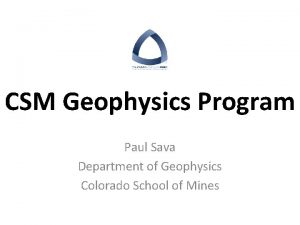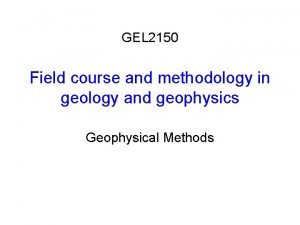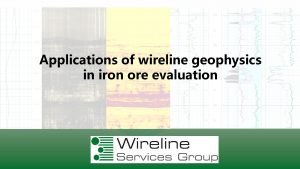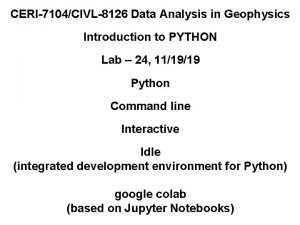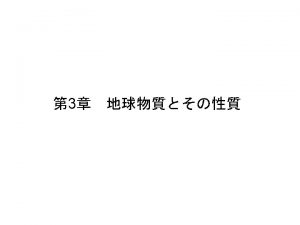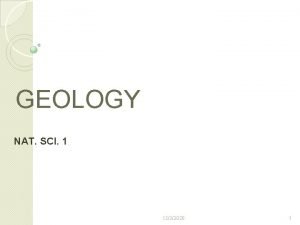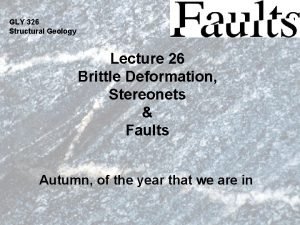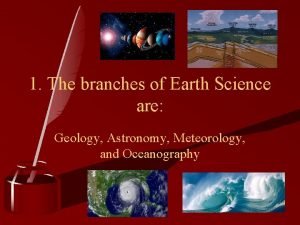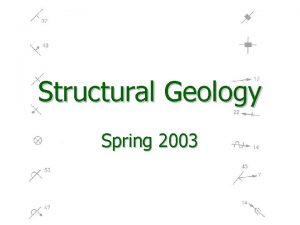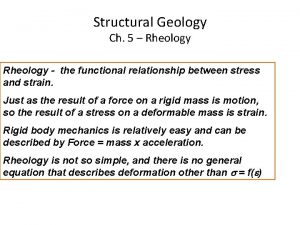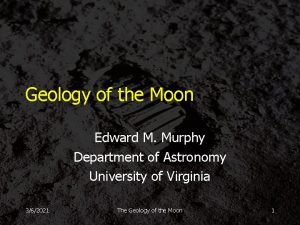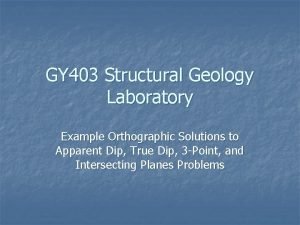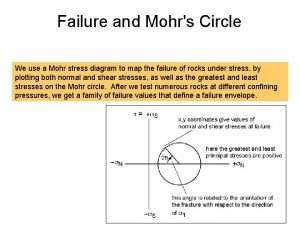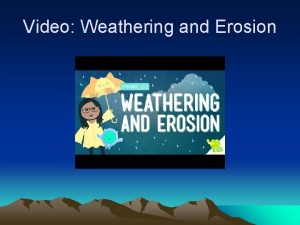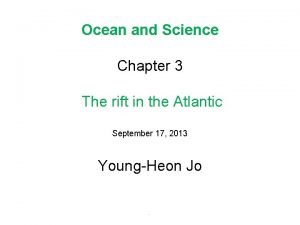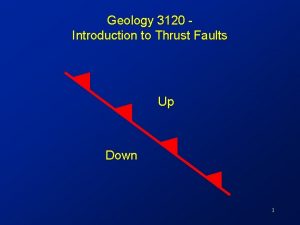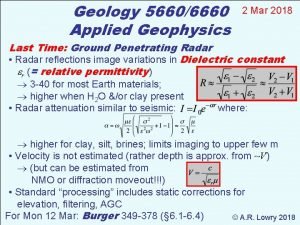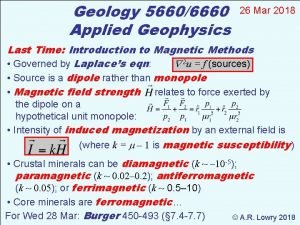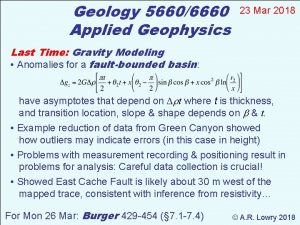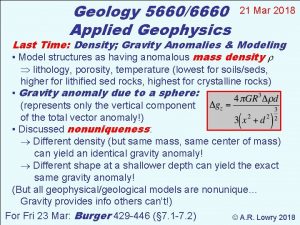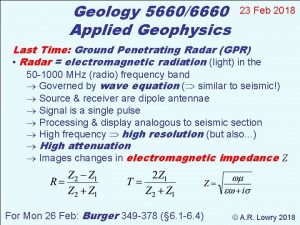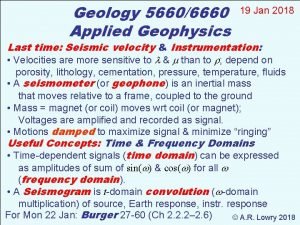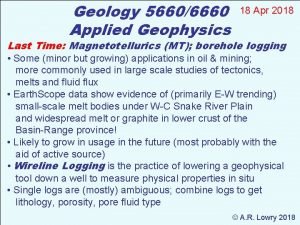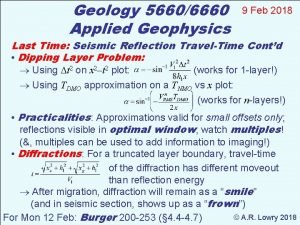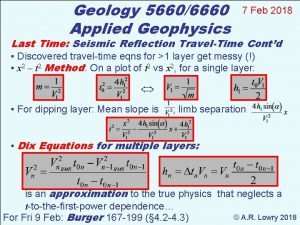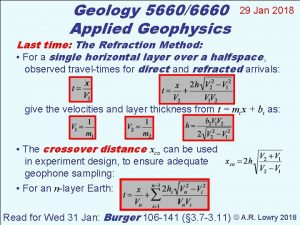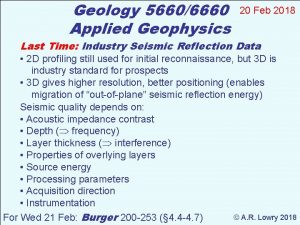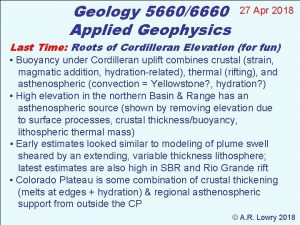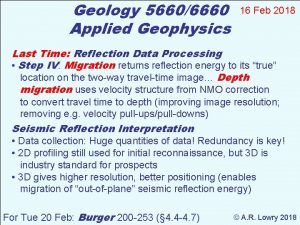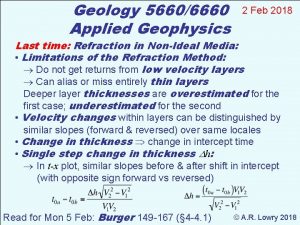Geology 56606660 Applied Geophysics 12 Mar 2018 Last



















- Slides: 19

Geology 5660/6660 Applied Geophysics 12 Mar 2018 Last Time: Introduction to Gravity • Governed by La. Place’s equation: with solution of the form: • If we have a spherical body with mass M and constant (or radially symmetric) density, this integral becomes: • Method looks for anomalies in gravity g (relative to the gravity expected for a uniform-density ellipsoid) that result from lateral changes in mass density • Measurements may be surface-based or space-based; absolute or relative For Wed 14 Mar: Burger 349 -378 (§ 6. 1 -6. 4) © A. R. Lowry 2018

Gravity Measurements: I. Absolute Gravity: Measure the total field time of a falling body vacuum prism laser ~2 m • Must measure time to ~10 -11 s; distance to ~10 -9 m for 1 gal accuracy! • Nevertheless this is the most accurate ground-based technique (to ~3 gal) • Disadvantages: unwieldy; requires a long occupation time to measure

Gravity Measurements: II. Relative Gravity: Measures difference in at two locations. • Pendulum: difference in period T: l Errors in timing of period T ~0. 1 mgal • Mass on a spring: M g = k l or g = k. Dl/M Worden and Lacoste-Romberg are of this type (“zero-length” spring of L-R yields errors around 6 gal) length l mass M spring constant k

Gravity Measurements: III. Satellite Gravity: Measure (from space) the height of an equipotential surface (called the geoid, N) relative to a reference ellipsoid.

Gravity Measurements: III. Satellite Gravity: Measure (from space) the height of an equipotential surface (called the geoid, N) relative to a reference ellipsoid • Ocean Altimetry: Measure height of the ocean surface using radar or laser (e. g. , SEASAT, JASON) • Satellite Ranging: Satellite orbits follow the geoid N Measure orbits by ranging from the ground to the satellite or ranging between two satellites (e. g. , GRACE)

Example: Global Free-Air Gravity Field from GRACE + GOCE + satellite altimetry + surface measurements… WGM 2012 model from Bureau Gravimetríque International

GRACE designed for time-variable gravity, mostly hydrosphere

GRACE Mass Trend 2003 -2010: Total mass trend (Jacob et al. , Nature, 2012) Corrected for solid Earth (i. e. , the residual relates to hydrology + cryosphere)

GRACE-derived mass trend over Greenland shows melting and accumulation; net loss is 222± 9 km 3/yr! Contributions to global sea level change: Greenland: 0. 61± 0. 02 mm/yr Antarctica: 0. 45± 0. 20 mm/yr Continental: 0. 41± 0. 08 mm/yr Ice total: 1. 48 Altimetry: 3. 3 Image from UT-CSR/NASA

But GRACE gives solid Earth info too! CARI (GPS)

Example: Free Air Gravity from Satellite Ocean Altimetry

(Note altimeters were actually intended to find out more about sea level change!)

Detail: Indian Ocean (East of Madagascar)

Detail: Western Pacific

Most structural studies use terrestrial (or surface-based) measurements: These require corrections: Recall: for spherical or point mass M Terrestrial measurement means setting a gravimeter down on the Earth’s surface… So measurements will include effects from changes in distance to Earth’s center of mass, mass attraction of (known) topography, and mass attractions of (unknown) interior density… We are only interested in the last so try to subtract out the other stuff.

Recall: for spherical or point mass M It’s also useful to recall that our expression for gravity due to a spherical mass came from an integral: And integrals can be approximated as sums!

Corrections include: • Tidal attractions from nearby heavenly bodies (dominated by distance to moon, sun, Jupiter) • Associated solid Earth tidal deformation • Mass of atmosphere above (function of atmospheric pressure) For these corrections, record time of measurement and atmospheric pressure.

Corrections include: • Earth’s ellipticity and spin Distance r from Earth’s (See text eqn 6. 12 for g 0, A & B) (1 Gal accuracy 1. 25 m latitude accuracy!) f 6356 km Latitude correction: center of mass is a function of latitude, so we subtract gravity at a specified ellipsoidal height from total. Earth’s rotation induces an outward (centrifugal) acceleration as a function of radial distance from axis of rotation (i. e. , latitude), so we correct for this also. 6378 km

Corrections include: • Altitude (“free air correction”) Following topography also results in differences in radial distance to the center of mass. Correction for that change in distance due to topography is called “free air”: More accurately, including the ellipsoid: (latter terms are small ~ – 0. 3086 m. Gal/m) (1 Gal accuracy 3 mm height accuracy!)
 Paul sava
Paul sava Seismology
Seismology Wireline geophysics
Wireline geophysics Python for geophysics
Python for geophysics Que letra continua m v t m j
Que letra continua m v t m j Prem geology
Prem geology Geology definition
Geology definition Oblique fault
Oblique fault Normal fault
Normal fault Earth science branches
Earth science branches Pumpelly's rule geology
Pumpelly's rule geology Structural geology
Structural geology Geology
Geology Geology earth science definition
Geology earth science definition Three point problem geology
Three point problem geology Mohr's type of test
Mohr's type of test Weathering video
Weathering video 5 themes of geography definition
5 themes of geography definition Wilson cycle
Wilson cycle Thrust geology
Thrust geology
